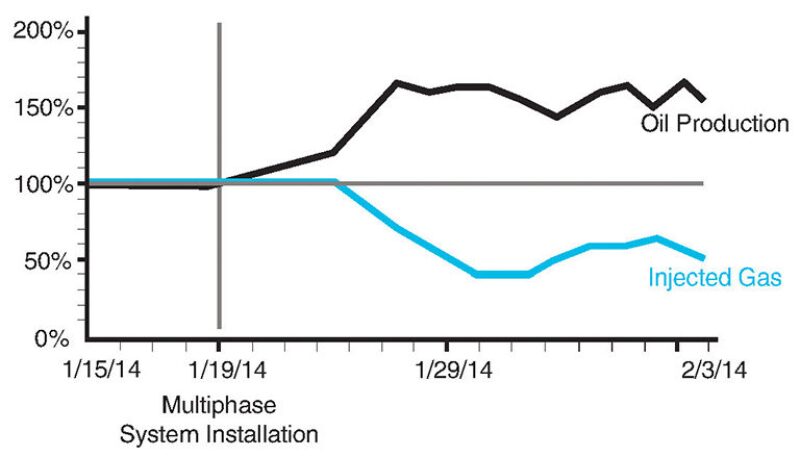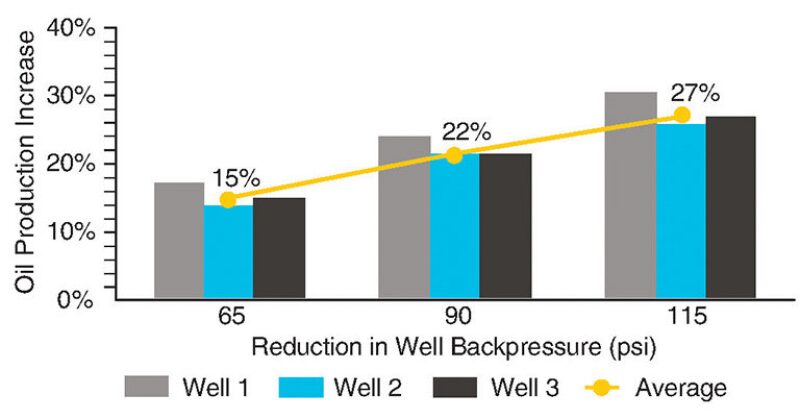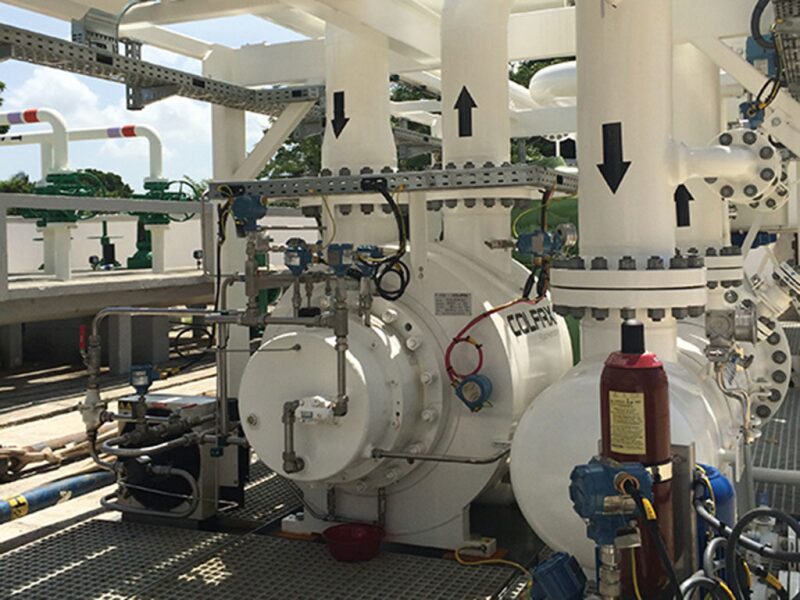Extending the useful producing life of the growing universe of mature wells has become a hot topic in today’s challenging oil production environment. With large reductions in new well and field development, and limited capital expenditure available for facility optimizations, prospects for production increases may appear dismal. But reasonable strategies to unlock stubborn reserves and optimize immediate production do exist.
Optimizing Surface Facilities
Optimizing production starts with looking critically at both downhole strategies and surface facilities. Altering downhole strategies (artificial lift pumps, gas lift, chemical treatments, etc.) has often proven effective; however, increasingly challenging wells can preclude such interventions. Difficult well geometries, depths, pressure variations, gas volumes, fluid compositions, or flow profiles are examples of such challenges.
For both these and relatively simple wells, improving surface facilities remains another sensible strategy for achieving substantial and immediate production increases. Wellhead facilities typically incorporate either a direct takeaway pipeline or a local separation and/or processing battery. In both cases, the wellhead facility exerts a required pressure on the well. For pipelines, this pressure transfers the production flow to a remote storage, transport, or processing facility; for local batteries, this pressure drives the production fluid through the battery. Reducing the pressure the wellhead facility has to exert on the well is a key factor in improving wellhead facilities to increase production.
Unfortunately, it is common to regard wellhead facilities as too expensive or impossible to alter in any consequential way. Yet this is far from the case. Two-screw multiphase pump systems (MPSs) may play a leading role in reducing required well pressures—extending the useful producing life of mature wells and immediately increasing production. MPSs are deployed between the wellhead and takeaway pipeline or local battery with minimal, if any, alterations to the current facilities. The MPS provides the flexibility to reduce wellhead pressure while boosting the pure well fluid (oil, gas, water, sand, and impurities) to the pressures required by the existing facilities.
In conventional centrifugal pumping, inlet pressure determines the performance of the pump. It is the other way around with a multiphase pump. As a positive displacement machine, the multiphase pump’s primary operating principle is fluid transfer, not pressure creation. Combining this principle with the compression properties of production gas results in the speed of the pump determining the pump’s inlet pressure and the resultant wellhead pressure. This makes it possible to decouple wellhead pressure from required facility pressures.
Case Studies
Two recent examples highlight the potential production benefits available by deploying MPSs in mature fields. The first is at an offshore wellpad in the Caspian Sea, connected to a local separation/takeaway battery. The second is at a remote onshore wellpad in Mexico, connected via multiphase pipelines to a distant central processing facility (CPF). Both examples highlight the wellhead pressure drop achieved by deploying the MPS technology and illustrate how the affected wells’ unique productivity indexes and natural production profiles responded with increased oil production.
In the Caspian Sea example, oil wells have been in operation since the 1950s in the Gum Deniz oil field. As natural pressure has declined, gas lift has been used to facilitate lifting of the 34 °API oil. Continual fluid volumes are above 98.4% gas volume fraction (GVF) with intermittent 100% gas slugs. The MPS was installed between the wellhead and local battery, dropping the wellhead pressure by 115 psi. The approximate results were a 70% increase in oil production with a 45% reduction in injected gas. Eight years of extended well life are estimated. (Fig. 1).

In the Mexico example, the oil wells have been producing 40 °API oil since the 1980s. Again, natural pressure decline has led to the adoption of gas lift in some of the wells. Continual fluid volumes reach 99.5% GVF with intermittent 100% gas slugs. The MPS was installed at a local manifold to route flow from a variety of wells to the distant CPF. The wellhead pressure was dropped by 90 psi, resulting in an approximately 25% increase in oil production, with no reduction of injected gas. Four years of extended well life are estimated (Fig. 2).

Although both examples are of gas-lifted, light crude wells, versatile two-screw MPSs have a broad applicability range. They can be particularly accommodating in challenging, gas-lifted situations where GVF exceeds 90%, to as much as 99.8% continuously or 100% intermittently. They remain effective and in routine use in 40% GVF applications and heavy crude fields. Additionally, MPSs are often used in tandem with artificial lift pumps to reduce the drain on the downhole equipment.
Application to Maturing Wells
The application versatility of the MPS technology stems from the heart of the systems, the two-screw multiphase pump [API STD 676(R2015)]. The pump casing includes an embedded liquid reservoir that releases liquid into the screw mechanisms to maintain internal sealing and dissipate heat generated from compressing the gas portion of the flow. The purpose of this design is to maintain the proper wetting of the screws without recirculating fluid back to suction, which improves the volumetric output while enabling pumping of extremely high GVF flows.
The pump incorporates a noncontacting design to enable the pumping of dirty, impure, and mixed phase fluids while minimizing wear. The self-priming screws help to avoid casing contact by using the hydraulic forces of the pumped fluid to axially balance the screws. This balancing is achieved by pumping equal parts of inlet flow from opposite ends of the pump to the center. The balancing is enhanced by external timing gears that provide mechanical drive while maintaining screw-to-screw alignment to prevent contact.
The full MPS surrounds the pumps with equipment to help ensure reliable, optimal operations. Smart pressure, temperature, and vibration sensors control pump operations through a customizable control system and variable speed drive. Lubrication and seal support systems provide pressure and temperature control for the pump’s bearings, timing gears, and seal components. In complex applications, strainers, coolers, and liquid capture and recirculation systems enhance flow control around and through the pump.
Two-screw MPSs are versatile machines with proven success in generating increased production in mature oil fields. The MPSs optimize existing wellhead surface facilities by decoupling wellhead pressure from required system pressures, enabling reduced wellhead pressures and increased oil flow. As wells mature and their economics become more difficult, especially in today’s environment, an MPS may mean the difference between shutting in wells and economically producing for years to come. OGF
For Further Reading
API STD 676 (R2015), Positive Displacement Pumps—Rotary, third edition. 2009. Washington, DC: API.


